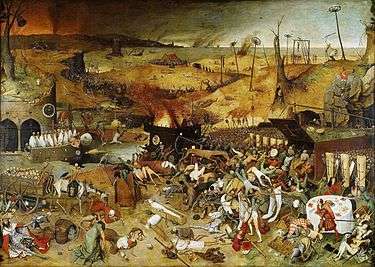The Triumph of Death
 | |
| Artist | Pieter Bruegel the Elder |
|---|---|
| Year | c. 1562 |
| Medium | oil on panel |
| Dimensions | 117 cm × 162 cm (46 in × 63.8 in) |
| Location | Museo del Prado, Madrid |
The Triumph of Death is an oil panel painting by Pieter Bruegel the Elder painted c. 1562.[1] It has been in the Museo del Prado in Madrid since 1827.[2]
Description
The painting shows a panorama of an army of skeletons wreaking havoc across a blackened, desolate landscape. Fires burn in the distance, and the sea is littered with shipwrecks. A few leafless trees stud hills otherwise bare of vegetation; fish lie rotting on the shores of a corpse-choked pond. Art historian James Snyder emphasizes the "scorched, barren earth, devoid of any life as far as the eye can see."[1] In this setting, legions of skeletons advance on the living, who either flee in terror or try in vain to fight back. In the foreground, skeletons haul a wagon full of skulls; in the upper left corner, others ring the bell that signifies the death knell of the world. A fool plays the lute while a lady sings; behind both of them a skeleton plays along; a starving dog nibbles at the face of a child; a cross sits in the center of the painting. People are herded into a coffin shaped trap decorated with crosses, while a skeleton on horseback kills people with a scythe. The painting depicts people of different social backgrounds – from peasants and soldiers to nobles as well as a king and a cardinal – being taken by death indiscriminately.[3]
A skeleton parodies human happiness by playing a hurdy-gurdy while the wheels of his cart crush a man. A woman has fallen in the path of the death cart; she holds in her hand a spindle and distaff, classical symbols of the fragility of human life. Near by another woman in the part of the cart has a slender thread which is about to be cut by the scissors in her other hand. Just below her a cardinal is helped towards his fate by a skeleton who mockingly wears the red hat, while a dying king's barrel of gold coins is looted by yet another skeleton. In one detail, a dinner has been broken up and the diners are putting up a futile resistance. They have drawn their swords in order to fight the skeletons dressed in winding-sheets; no less hopelessly, the jester takes refuge beneath the dinner table. The backgammon board and the playing cards have been scattered, while a skeleton thinly disguised with a mask empties away the wine flasks. Above, a woman is being embraced by a skeleton in a hideous parody of after-dinner amorousness. Of the menu of the interrupted meal, all that can be seen are a few pallid rolls of bread and an appetizer apparently consisting of a pared human skull. As the fighting breaks out, a skeleton in a hooded robe mockingly seems to bring another dish, also consisting of human bones, to the table.[4]
The painting shows aspects of everyday life in the mid-sixteenth century. Clothes are clearly depicted, as are pastimes such as playing cards and backgammon. It shows objects such as musical instruments, an early mechanical clock, scenes including a funeral service, and various methods of execution, including the breaking wheel, the gallows, and the headsman. In one scene a human is the prey of a skeleton-hunter and his dogs. In another scene a man with a grinding stone around his neck is about to be thrown into the pond.
Bruegel combines two distinct visual traditions within the panel. These are his native tradition of Northern woodcuts of the Dance of Death and the Italian conception of the Triumph of Death, as in frescoes he would have seen in the Palazzo Sclafani in Palermo and in the Camposanto Monumentale at Pisa.[5]
Notes
- 1 2 Snyder, James (1985). Northern Renaissance Art: Painting, Sculpture, the Graphic Arts from 1350 to 1575. New York: Harry N. Abrams. p. 486. ISBN 0-8109-1081-0.
- ↑ Pallucchini, Anna; Ragghianti, Carlo Ludovico; Collobi, Licia Ragghianti (1968). Prado, Madrid. Great Museums of the World. New York: Newsweek. p. 134.
- ↑ Woodward, Richard B. (February 14, 2009). "Death Takes No Holiday". The Wall Street Journal. Retrieved December 22, 2011.
- ↑ G. Gluck, Piter Bruegel the Elder, London (1958), s.v. "Triumph of Death". See also Rose-Marie and Rainer Hagen, Bruegel: The Complete Paintings. aka Pieter Bruegel the Elder: peasants, fools and demons, Taschen (2004).
- ↑ P. Thon, "Bruegel's Triumph of Death Reconsidered", Renaissance Quarterly Vol. 21, No. 3, Autumn, 1968.
References
 This article incorporates text from a publication now in the public domain: Chisholm, Hugh, ed. (1911). "article name needed". Encyclopædia Britannica (11th ed.). Cambridge University Press.
This article incorporates text from a publication now in the public domain: Chisholm, Hugh, ed. (1911). "article name needed". Encyclopædia Britannica (11th ed.). Cambridge University Press.
Further reading
- Friedländer, M.J., Early Netherlandish Painting. Volume XIV: Pieter Bruegel, (Engl. transl.) Leyden (1976).
- Gibson, W.S. (1977). Bruegel. London.
- Grossman, F. (1973). Pieter Bruegel: Complete Edition of the Paintings (3rd ed.). London.
- Stechow, W. (1969). Pieter Bruegel. New York.
External links
| Wikimedia Commons has media related to The Triumph of Death by Peter Bruegel. |
| Wikimedia Commons has media related to Pieter Bruegel the Elder. |
- www.Pieter-Bruegel-The-Elder.org 99 works by Pieter Bruegel the Elder
- Creativity Brueghel laid the foundation of the Netherlands School
